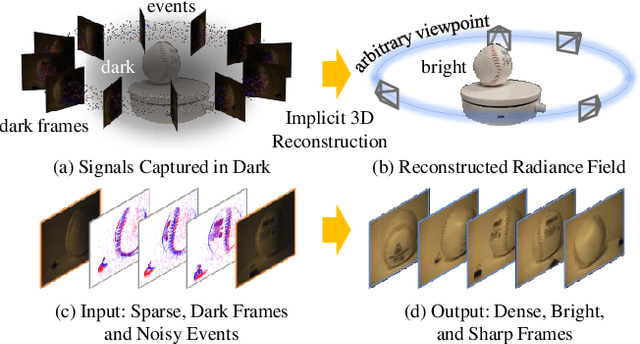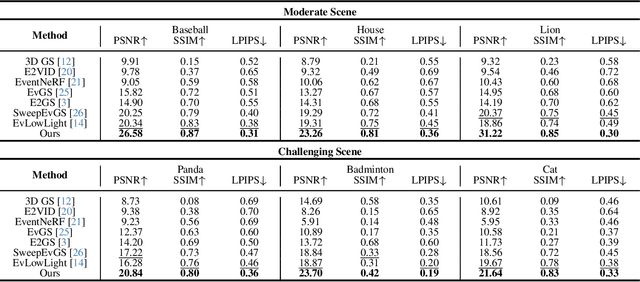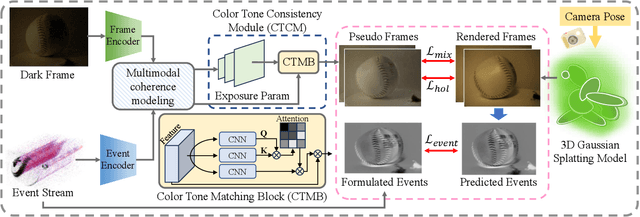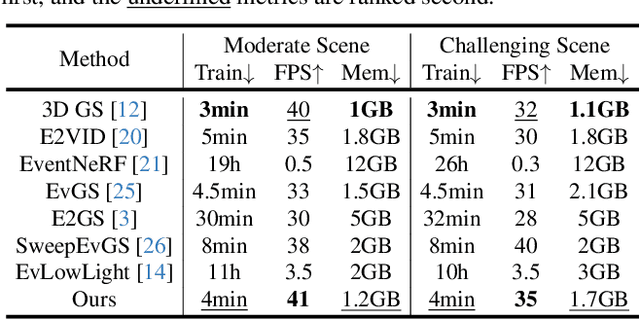Boxin Shi
PolarAnything: Diffusion-based Polarimetric Image Synthesis
Jul 24, 2025Abstract:Polarization images facilitate image enhancement and 3D reconstruction tasks, but the limited accessibility of polarization cameras hinders their broader application. This gap drives the need for synthesizing photorealistic polarization images. The existing polarization simulator Mitsuba relies on a parametric polarization image formation model and requires extensive 3D assets covering shape and PBR materials, preventing it from generating large-scale photorealistic images. To address this problem, we propose PolarAnything, capable of synthesizing polarization images from a single RGB input with both photorealism and physical accuracy, eliminating the dependency on 3D asset collections. Drawing inspiration from the zero-shot performance of pretrained diffusion models, we introduce a diffusion-based generative framework with an effective representation strategy that preserves the fidelity of polarization properties. Experiments show that our model generates high-quality polarization images and supports downstream tasks like shape from polarization.
BokehDiff: Neural Lens Blur with One-Step Diffusion
Jul 24, 2025Abstract:We introduce BokehDiff, a novel lens blur rendering method that achieves physically accurate and visually appealing outcomes, with the help of generative diffusion prior. Previous methods are bounded by the accuracy of depth estimation, generating artifacts in depth discontinuities. Our method employs a physics-inspired self-attention module that aligns with the image formation process, incorporating depth-dependent circle of confusion constraint and self-occlusion effects. We adapt the diffusion model to the one-step inference scheme without introducing additional noise, and achieve results of high quality and fidelity. To address the lack of scalable paired data, we propose to synthesize photorealistic foregrounds with transparency with diffusion models, balancing authenticity and scene diversity.
Dark-EvGS: Event Camera as an Eye for Radiance Field in the Dark
Jul 16, 2025



Abstract:In low-light environments, conventional cameras often struggle to capture clear multi-view images of objects due to dynamic range limitations and motion blur caused by long exposure. Event cameras, with their high-dynamic range and high-speed properties, have the potential to mitigate these issues. Additionally, 3D Gaussian Splatting (GS) enables radiance field reconstruction, facilitating bright frame synthesis from multiple viewpoints in low-light conditions. However, naively using an event-assisted 3D GS approach still faced challenges because, in low light, events are noisy, frames lack quality, and the color tone may be inconsistent. To address these issues, we propose Dark-EvGS, the first event-assisted 3D GS framework that enables the reconstruction of bright frames from arbitrary viewpoints along the camera trajectory. Triplet-level supervision is proposed to gain holistic knowledge, granular details, and sharp scene rendering. The color tone matching block is proposed to guarantee the color consistency of the rendered frames. Furthermore, we introduce the first real-captured dataset for the event-guided bright frame synthesis task via 3D GS-based radiance field reconstruction. Experiments demonstrate that our method achieves better results than existing methods, conquering radiance field reconstruction under challenging low-light conditions. The code and sample data are included in the supplementary material.
Light of Normals: Unified Feature Representation for Universal Photometric Stereo
Jun 24, 2025Abstract:Universal photometric stereo (PS) aims to recover high-quality surface normals from objects under arbitrary lighting conditions without relying on specific illumination models. Despite recent advances such as SDM-UniPS and Uni MS-PS, two fundamental challenges persist: 1) the deep coupling between varying illumination and surface normal features, where ambiguity in observed intensity makes it difficult to determine whether brightness variations stem from lighting changes or surface orientation; and 2) the preservation of high-frequency geometric details in complex surfaces, where intricate geometries create self-shadowing, inter-reflections, and subtle normal variations that conventional feature processing operations struggle to capture accurately.
Audio-Sync Video Generation with Multi-Stream Temporal Control
Jun 09, 2025Abstract:Audio is inherently temporal and closely synchronized with the visual world, making it a naturally aligned and expressive control signal for controllable video generation (e.g., movies). Beyond control, directly translating audio into video is essential for understanding and visualizing rich audio narratives (e.g., Podcasts or historical recordings). However, existing approaches fall short in generating high-quality videos with precise audio-visual synchronization, especially across diverse and complex audio types. In this work, we introduce MTV, a versatile framework for audio-sync video generation. MTV explicitly separates audios into speech, effects, and music tracks, enabling disentangled control over lip motion, event timing, and visual mood, respectively -- resulting in fine-grained and semantically aligned video generation. To support the framework, we additionally present DEMIX, a dataset comprising high-quality cinematic videos and demixed audio tracks. DEMIX is structured into five overlapped subsets, enabling scalable multi-stage training for diverse generation scenarios. Extensive experiments demonstrate that MTV achieves state-of-the-art performance across six standard metrics spanning video quality, text-video consistency, and audio-video alignment. Project page: https://hjzheng.net/projects/MTV/.
PacTure: Efficient PBR Texture Generation on Packed Views with Visual Autoregressive Models
May 28, 2025Abstract:We present PacTure, a novel framework for generating physically-based rendering (PBR) material textures from an untextured 3D mesh, a text description, and an optional image prompt. Early 2D generation-based texturing approaches generate textures sequentially from different views, resulting in long inference times and globally inconsistent textures. More recent approaches adopt multi-view generation with cross-view attention to enhance global consistency, which, however, limits the resolution for each view. In response to these weaknesses, we first introduce view packing, a novel technique that significantly increases the effective resolution for each view during multi-view generation without imposing additional inference cost, by formulating the arrangement of multi-view maps as a 2D rectangle bin packing problem. In contrast to UV mapping, it preserves the spatial proximity essential for image generation and maintains full compatibility with current 2D generative models. To further reduce the inference cost, we enable fine-grained control and multi-domain generation within the next-scale prediction autoregressive framework to create an efficient multi-view multi-domain generative backbone. Extensive experiments show that PacTure outperforms state-of-the-art methods in both quality of generated PBR textures and efficiency in training and inference.
PanoWan: Lifting Diffusion Video Generation Models to 360° with Latitude/Longitude-aware Mechanisms
May 28, 2025Abstract:Panoramic video generation enables immersive 360{\deg} content creation, valuable in applications that demand scene-consistent world exploration. However, existing panoramic video generation models struggle to leverage pre-trained generative priors from conventional text-to-video models for high-quality and diverse panoramic videos generation, due to limited dataset scale and the gap in spatial feature representations. In this paper, we introduce PanoWan to effectively lift pre-trained text-to-video models to the panoramic domain, equipped with minimal modules. PanoWan employs latitude-aware sampling to avoid latitudinal distortion, while its rotated semantic denoising and padded pixel-wise decoding ensure seamless transitions at longitude boundaries. To provide sufficient panoramic videos for learning these lifted representations, we contribute PanoVid, a high-quality panoramic video dataset with captions and diverse scenarios. Consequently, PanoWan achieves state-of-the-art performance in panoramic video generation and demonstrates robustness for zero-shot downstream tasks.
Affective Image Editing: Shaping Emotional Factors via Text Descriptions
May 24, 2025Abstract:In daily life, images as common affective stimuli have widespread applications. Despite significant progress in text-driven image editing, there is limited work focusing on understanding users' emotional requests. In this paper, we introduce AIEdiT for Affective Image Editing using Text descriptions, which evokes specific emotions by adaptively shaping multiple emotional factors across the entire images. To represent universal emotional priors, we build the continuous emotional spectrum and extract nuanced emotional requests. To manipulate emotional factors, we design the emotional mapper to translate visually-abstract emotional requests to visually-concrete semantic representations. To ensure that editing results evoke specific emotions, we introduce an MLLM to supervise the model training. During inference, we strategically distort visual elements and subsequently shape corresponding emotional factors to edit images according to users' instructions. Additionally, we introduce a large-scale dataset that includes the emotion-aligned text and image pair set for training and evaluation. Extensive experiments demonstrate that AIEdiT achieves superior performance, effectively reflecting users' emotional requests.
V2V: Scaling Event-Based Vision through Efficient Video-to-Voxel Simulation
May 22, 2025Abstract:Event-based cameras offer unique advantages such as high temporal resolution, high dynamic range, and low power consumption. However, the massive storage requirements and I/O burdens of existing synthetic data generation pipelines and the scarcity of real data prevent event-based training datasets from scaling up, limiting the development and generalization capabilities of event vision models. To address this challenge, we introduce Video-to-Voxel (V2V), an approach that directly converts conventional video frames into event-based voxel grid representations, bypassing the storage-intensive event stream generation entirely. V2V enables a 150 times reduction in storage requirements while supporting on-the-fly parameter randomization for enhanced model robustness. Leveraging this efficiency, we train several video reconstruction and optical flow estimation model architectures on 10,000 diverse videos totaling 52 hours--an order of magnitude larger than existing event datasets, yielding substantial improvements.
NTIRE 2025 Challenge on Event-Based Image Deblurring: Methods and Results
Apr 16, 2025Abstract:This paper presents an overview of NTIRE 2025 the First Challenge on Event-Based Image Deblurring, detailing the proposed methodologies and corresponding results. The primary goal of the challenge is to design an event-based method that achieves high-quality image deblurring, with performance quantitatively assessed using Peak Signal-to-Noise Ratio (PSNR). Notably, there are no restrictions on computational complexity or model size. The task focuses on leveraging both events and images as inputs for single-image deblurring. A total of 199 participants registered, among whom 15 teams successfully submitted valid results, offering valuable insights into the current state of event-based image deblurring. We anticipate that this challenge will drive further advancements in event-based vision research.
 Add to Chrome
Add to Chrome Add to Firefox
Add to Firefox Add to Edge
Add to Edge